Since 1980, when a periodic façade inspection and repair program (Local Law 11) was legislated in New York City (NYC), five fatalities have been caused by facades of buildings whose inspection is mandated by the program. Over the same period, there were five fatalities due to the collapses of parapets to which business signs were affixed. However, when a similar fatal accident involving a business sign occurred in the neighboring Westchester County, the New York Times reported that the Yonkers Fire Chief qualified it as a freak accident. Questioning this assertion, this article provides an overview of sign-related incidents in NYC and offers explanations of the most likely causes of fatal accidents.
Standards and Regulations
Appendix H of the International Building Code provides several requirements for sign design, installation, and acceptable materials. While the technical literature mentions façade accidents and abounds with articles regarding façade inspection, it is difficult to find texts discussing accidents related to signs affixed to buildings. This article tries to make a start in this direction and reflects observations on data collected in NYC.
Local jurisdictions (Chicago, Philadelphia, etc.) permit signs according to their zoning statutes. NYC regulations use sign as a zoning term defined as “any writing—words, pictures, or symbols—that is on or attached to a building or other structure.” The city’s zoning resolution provides specific definitions for accessory signs, which “directs attention to a business, profession, commodity, service or entertainment conducted, sold, or offered upon the same zoning lot,” and advertising signs, which “directs attention to a business, profession, commodity, service or entertainment conducted, sold, or offered on a different zoning lot.” Outdoor advertising has a long history that started in the 1800s. It involves serious amounts of money. Ordinances trying to prohibit billboards in cities were litigated to the US Supreme Court.
Engineering standards pay special attention to the effect of wind on signs. Specific instructions for design can be found in ASCE 7-22 Minimum Design Loads and Associated Criteria for Buildings and Other Structures, Section 29.3 Design Wind Loads: Solid Freestanding Walls and Solid Signs, and in 29.3.2 Solid Attached Signs, as well as in 4.8.2 Ordinary Roofs, Awnings, and Canopies. However, the accidents discussed here did not result from significant environmental loads. There is probably no need to discuss the ASCE 7 provisions since an article on wind design of canopies was published in STRUCTURE in July 2020. The article referenced ASCE 7-16, but its specific provisions have been kept in the current ASCE 7-22. An engineer can also find useful criteria for design in the AASHTO LRFD Specifications for Structural Supports for Highway Signs, Luminaires, and Traffic Signals. The NYC Building Code, Appendix H, contains requirements beyond those in IBC. It also makes owners responsible for the yearly inspection of outdoor signs.
Wind Incidents in NYC
A search of NYC wind incidents of the past 25 years noted few incidents that identify a notable collapse of a sign or billboard in high winds. However, in 1999, a large vinyl billboard was ripped by 40 mph gusts injuring 3 people in the Times Square area. More recently, a billboard was involved in a serious accident when the blades of a collapsing wind turbine hit it.
In January 2012, during moderate winds, a monopole collapsed, damaging three buildings. A large billboard was attached to the arm of the monopole. The collapse was due to the fracture of rusted bolts attaching the monopole to its foundation. The rust resulted from ponding water around the top of the foundation, surrounded by dirt. The fatigue from intermittent wind actions over the years might have also weakened the bolts. In the aftermath, the relatively few monopoles existing in NYC were inspected, and regulation for annual inspection was issued.
In the first decade of the 2000s, there were several failures of sidewalk sheds with large signs attached to their parapets. In some cases, owners kept sidewalk sheds only to collect fees for advertising signs. The sidewalk sheds were permitted according to an antiquated design that had not accounted for wind loads. The standard required only a 4-foot parapet, but the installed advertising signs far exceeded this height, and it was no surprise that the failures occurred under modest wind loads. Again, more stringent enforcement eliminated advertising signs on sheds and allowed only accessory signs that met the 4-foot height of the parapet.
Some Data
Over the past 20 years in NYC, there were accidents related to failures of monopoles, signs affixed to temporary installations, and signs affixed to facades. Table 1 lists the number of violations issued for accidents or deficient sign conditions for the period 2009-2021. The statistics presented in this section were obtained from NYC Open Data lists of applications and violations that were searched for texts that included the words: sign, awning, or billboard.
Some simple statistics are listed to provide some context to the cases of fatality and sign deterioration. It is difficult to approximate how many signs exist in the city. Considering only store accessory signs, a segment of the total sign population, one can first approximate about 30,600 buildings containing stores. Since many buildings contain several stores, the number of accessory store signs might be over 50,000.
Since only window signs or very small signs are exempt from permitting, one can estimate the total number of signs by considering there have been 22,521 applications submitted since 2000. However, this approach may be unreliable as the applications might include replacing previously permitted signs.
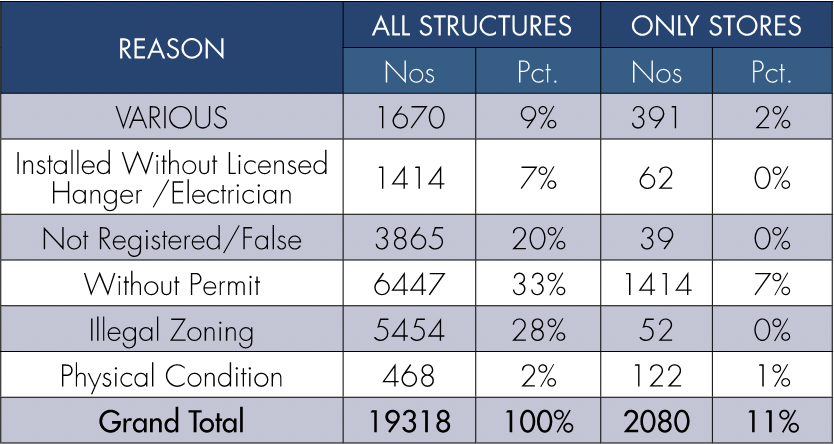
Applications for sign installations can be signed by Licensed Sign Hangers when they are less than 150 square feet and up to 300 pounds. Out of the total of 22,521 sign applications submitted since 2000, licensed engineers (PEs) signed 9,303 (41%) and registered architects (RAs) 6.085 (27%). Of the 2,486 applications that mentioned a structure, RAs signed 638 and PEs 1,837. The pool of licensed applicants is diverse and consists of about 400 different PEs and close to 600 RAs.
In NYC, regulation of individual signs in terms of size, surface area, type of illumination, and height is pegged on the zoning district category. The number of non-compliant sign installations, especially with zoning resolutions, reached such high numbers that in 2019 a moratorium on penalties was issued. A listing of the type of violations can be seen in Table 1. Note that the “ONLY STORES” column contains only violations related to accessory signs. Over 90% of violations result from installations without a permit or not permitted in the respective zoning district. The 19,318 violations were issued to 5,300 addresses over 13 years (2009-2021). Aside from miscellaneous violations, the “VARIOUS“ category includes mostly noncompliance with fire regulations (e.g., installations blocking exits or containing flammable materials). Only 2% of violations describe a deteriorating condition or an actual partial or total collapse. The addresses of buildings with stores account for 1,316 violations; the balance represents 4,000 addresses, probably with advertising signs.
Like in the case of façades, the most common sign accidents are due to material deterioration and occur in the absence of major environmental events. Table 2 lists the deficiencies described in violations for the period 2009-2021. The entries are self-explanatory.
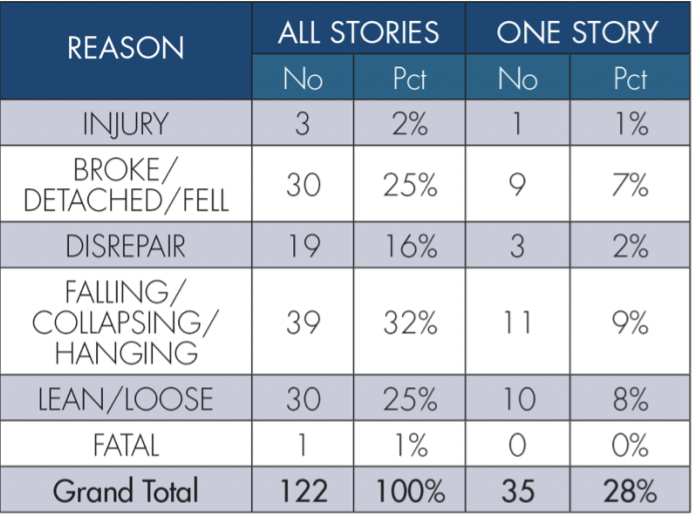
Fatalities
In 1973, the NYC Buildings Department enacted a rule requiring a competent person’s yearly inspection of masonry parapets. Only one- or two-family residences were excused. This regulation, later known as §32-04 Masonry Parapet Walls, was incorporated into the Administrative Code. It was triggered by the death of three people crushed by the collapse of a parapet holding store signs. The text in §32-04 specified, “Structural members supporting parapet walls shall be designed to resist torsional stresses.”

It is not clear if this regulation was complied with over the years. It does not seem to have been enforced as it is not mentioned in any violation. But one should consider that store signs are placed in areas of maximum visibility on purpose. Their condition is in plain sight. A neglected sign would not draw customers into the store. Because most signs are set above the first floor of a building, any major deficiency (loose, lean, detached, etc.) is more likely to be noticed than a façade deficiency occurring high above the curb. The number of violations in Table 1 is evidence of the systematic attention given by building inspectors. A building inspector field-inspecting the legality of a sign installation in a certain zoning district is also likely to notice conditions that might lead to collapse.
Fatalities caused by parapets with affixed signs occurred in December 1990, May 1998, April 1994, August 2002, and December 2021. In 2003, the parapet of a store collapsed, injuring a person. In 2007, the author performed a forensic analysis when a parapet and business sign collapsed, injuring three people, including a young boy that had a foot amputated.
All these accidents, including the fatal 1973 case, occurred on taxpayer buildings. In real estate, a taxpayer building refers to a one- or two-story commercial building built along a commercial artery. In NYC, these types of buildings started to be erected during the Depression to cover the property taxes on the lot. The expectation was that the lot would increase in value and be redeveloped. Usually, the building is divided into smaller stores, each with its own sign attached along the common parapet (this was the case in four collapse cases). The poor construction and especially the inadequate firewall separating the stores are known to cause serious fire hazards. In the vast majority of cases, glass windows and doors cover the entire frontage to serve the commercial purpose of the establishment (Figure 1). The parapet supporting the sign is set directly over a steel lintel beam. In NYC, about 5,600 taxpayer buildings were built between 1920 and 1960, containing over 14,600 commercial units.
The accident shown in Figures 2 and 3 occurred in 2007. The collapsed sign was one of a series of signs attached to a building built in 1950. The building is classified as a Multi-Story Retail Building, but a one-story taxpayer structure occupies the frontage. The building contained five stores along its 125-foot frontage. Over the years, there have been about 20 submittals related to this building’s electrical sign inspections or sign changes. In 1998 the façade was repaired, and a continuous cavity wall parapet was installed over the entire frontage.
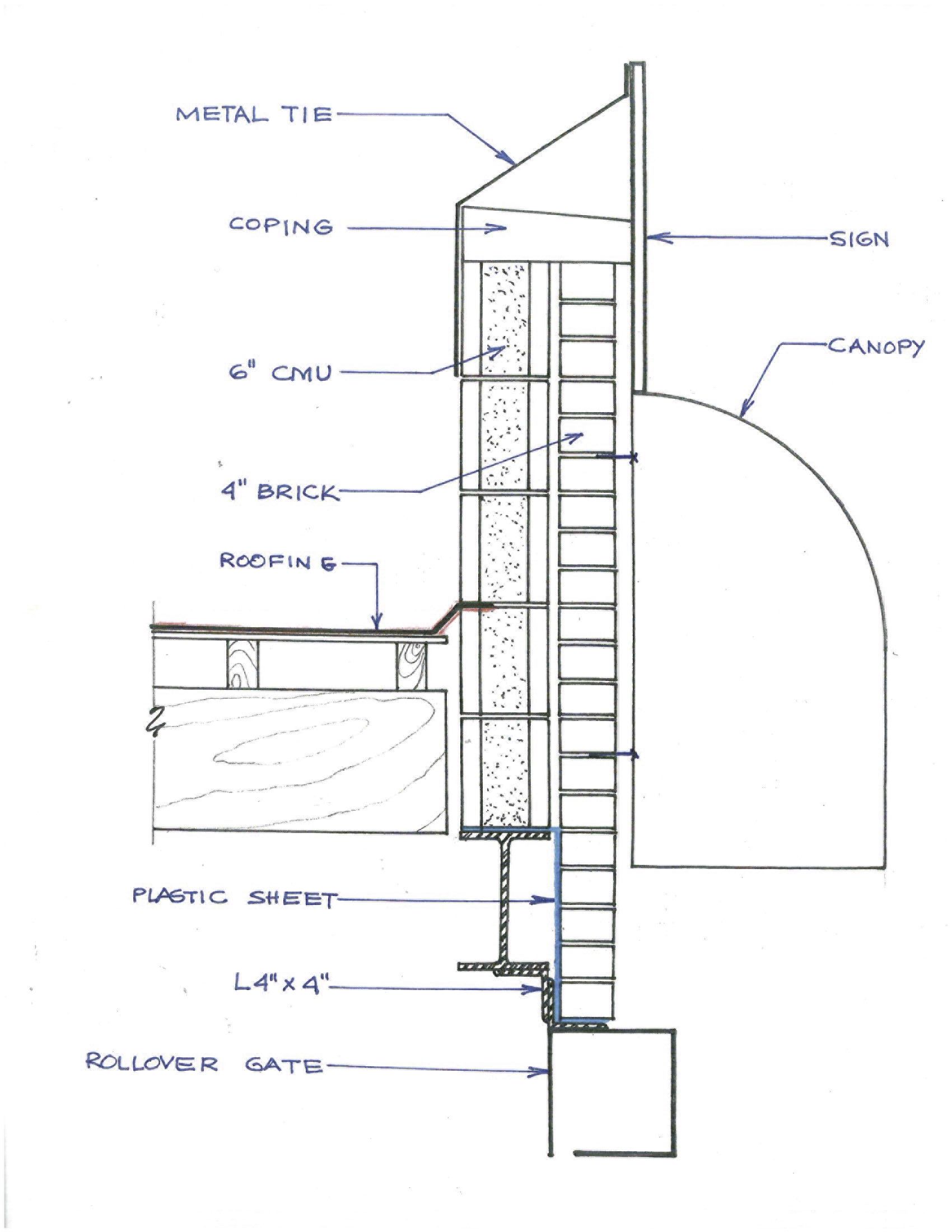
The signage included an awning with a 3.5-foot flat sign installed above that exceeded the coping stone’s level. The backup CMU was grouted and reinforced but was not attached to the beam below. As observed in Figure 2, the masonry was placed on top of plastic sheet flashing that protected the steel lintel. The roof waterproofing, partially placed in the CMU joints, was the only lateral attachment. The stability of the parapet was practically provided by self-weight and the resulting friction between CMU and flashing. It can be inferred that, over time, under intermittent moderate winds that had acted horizontally on the sign and that also induced a downward rotation of the awning, the parapet started to slightly “walk.” This particular accident occurred on a reconstructed parapet, but it illustrates a weakness that most likely led to fatalities in other cases – large signs attached to masonry parapets not anchored to the supporting steel beams. Except for their weight, these parapets do not have any system to prevent overturning. The return (perpendicular) parapet may help provide stability on shorter facades, but these returns are as far apart as taxpayer buildings have long frontages. The subdivision of the taxpayers into smaller stores creates conditions where tenants may use large signs and awnings as they compete for pedestrians’ attention.
Should these accidents be considered parapet collapses or sign collapses? The parapet is one of the most vulnerable components of a façade, especially because of its exposure to elements on both sides. Table 3 provides statistics obtained by searching NYC Open Data texts of violations that indicated some deficient parapet condition but did not include the word sign. The buildings containing retail stores seem to have deficient parapets at a higher ratio than most other buildings. The statistics in Table 3 are not all entirely relevant as signs at multi-story buildings are usually attached at the spandrel over the first floor and would not affect the condition of the parapet. Also, many NYC multi-story buildings have cornices that hide the condition of parapets, and violations would not mention parapets. However, the data for one-story retail buildings is pertinent to the discussion as signs are highly likely to be attached to the parapets of these buildings. The amplified risk is significant for these 7760 buildings that represent about 1% of the NYC building stock and 5% percent of collapsed parapets incidents. This table does not include the violations/collapses shown in Table 2.
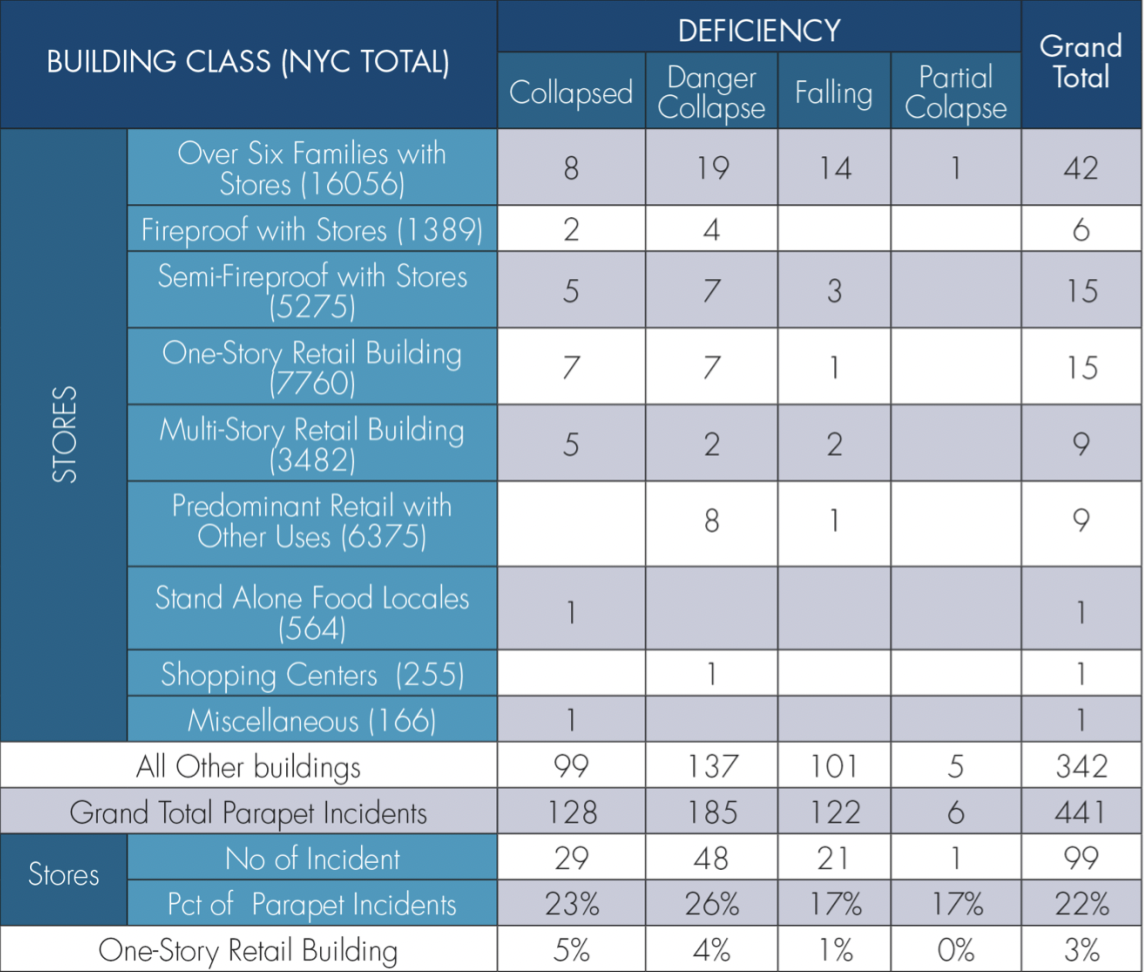
Discussion
In the case of fatal accidents, the signs and the parapets of taxpayer buildings were at relatively low heights, and a fall from a lower height develops limited energy. Still, descriptions of these accidents mention a rain of bricks as large segments of masonry fell. The fatalities belong to a particular typology of store signs and should not be considered an indication of particularly hazardous conditions posed by most signs. Because these taxpayer signs are placed along busy arteries, the dense presence of pedestrians increases the possibility of injury. As evidenced by the high ratio of occurrence of parapet collapses, the failures are most likely due to flaws in the installation of the parapet. The number of collapsed parapets (Table 3) strongly indicates their fragility. About 15,000 facades are being periodically inspected in NYC. Despite repeated repair campaigns, over the period from 2006 -2019, there were 29 parapet-related incidents (some included in Table 3).
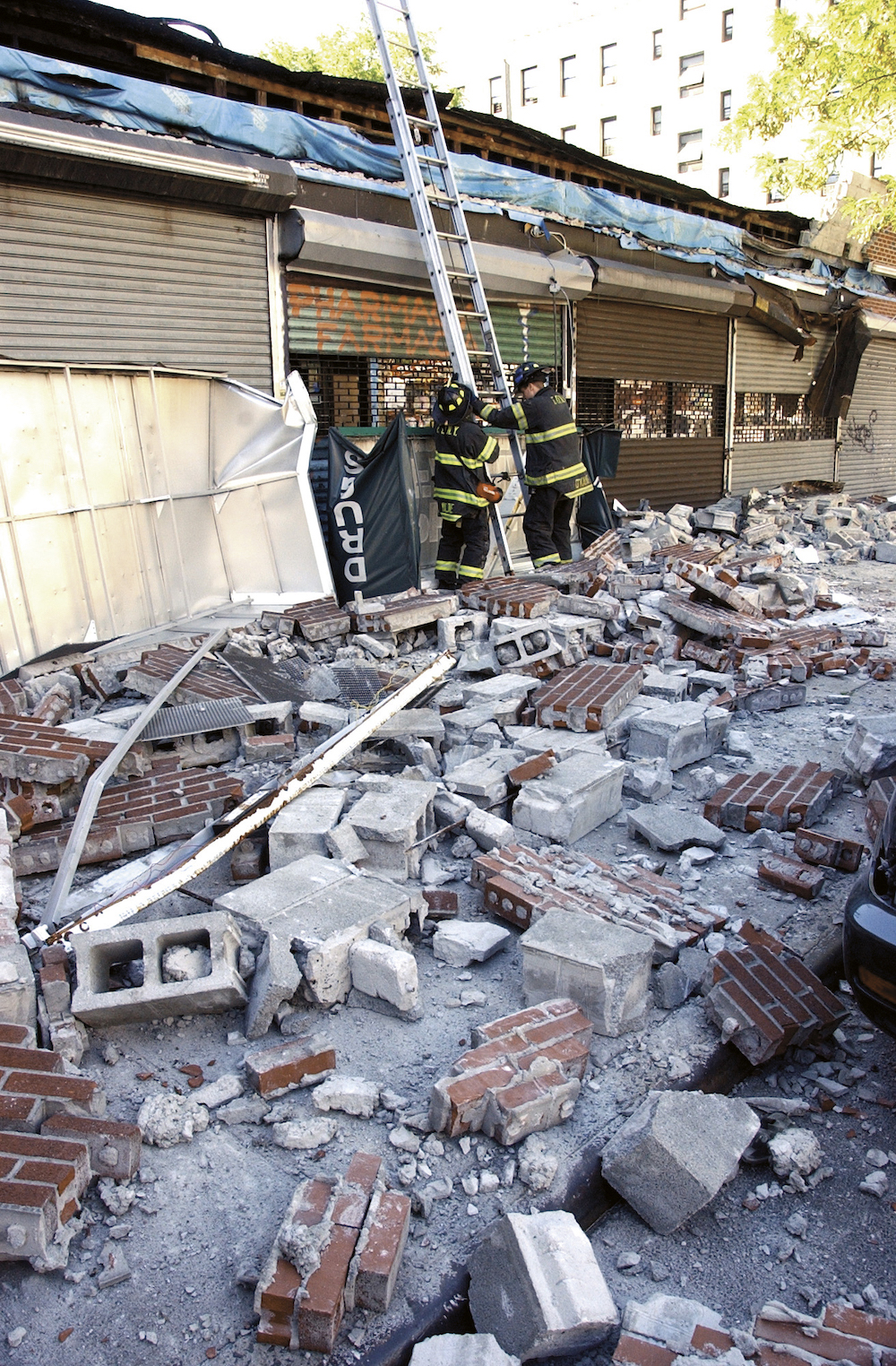
Facades and weather-exposed accessories deteriorate, but timely observations should prevent accidents. As demonstrated by the number of violations, signs are under serious scrutiny through inspection protocols. Statutes also require owners to inspect every year. Although the data collected here could not be adequately normalized, the ratio of violations indicating physical deficiencies versus an actual collapse needs to be given some consideration: out of 35 violations of signs on one-story buildings, 10 were related to a condition of broken, detached, or had fallen (Table 2). From Table 3, out of 15 violations related to parapets of one-story retail buildings, seven registered an actual collapse. No large-scale statistics provide criteria for acceptable ratios, but those listed here seem worrisome.
The fatalities discussed were caused by collapses of masonry parapets. The attached signs or awnings might have masked the condition of the supporting masonry parapet, and thus contributed to the accidents. The NY Times article describing the Yonkers accident also quoted a building engineer for the city’s Bureau of Housing and Buildings; the engineer stated that signs along the building front could obscure cracks that might signal damage from the elements. This was a much more accurate assessment.
